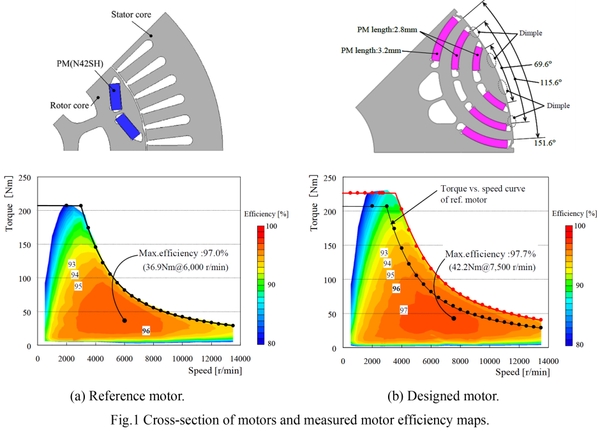Presentation Information
[O6-2]Design Studies on IPMSM with Radially Oriented Arc-Shaped Metal Magnet for Automotive Traction Drives
Jumpei Hinata1, *Takanori Kajiwara1, Takashi Oikawa1, Yoshiaki Kano2 (1. Corporate R&D center, Daido Steel Co., Ltd. (Japan), 2. Dept. of Electrical and Electronics Engineering, Daido University (Japan))
Keywords:
xEV,IPMSM,Nd-Fe-B magnet,Hot-deformed magnet,Arc-Shaped magnet
In recent years, hybrid vehicles (HEVs) and electric vehicles (EVs) have become increasingly popular due to global warming countermeasures and stricter CO2 emission regulations, and HEV drive motors are required to have high torque at low speed and high efficiency in the low, medium and high-speed ranges. Furthermore, there are growing demands for higher output from improved dynamic performance. To meet these requirements, it is important to optimize the design of an Interior Permanent Magnet Synchronous Motor (IPMSM) that can utilize reluctance torque effectively. However, conventional IPMSMs employ a rotor structure that assumes rectangular sintered rare earth magnets [1]-[4], making it difficult to maximize reluctance torque due to magnet shape constraints.
In this report, a new rotor structure with radially oriented arc-shaped Nd-Fe-B hot-deformed magnets embedded in arc-shaped multi-layer flux barriers is proposed as a rotor structure suitable for improving reluctance torque. Specifically, a rotor structure with a single-layer V-shape arrangement is used as a reference motor, and a rotor shape with a three-layer arc arrangement is designed to simultaneously achieve a 20% increase in maximum output and high efficiency while maintaining maximum torque.
A prototype of the IPMSM was prepared, and the motor performance was evaluated by a dynamometer, achieving improvements of 9.2% in maximum torque and 30.4% in maximum output compared to the reference machine (Fig. 1). As for efficiency, a 0.7% improvement in maximum efficiency and an expansion of the high-efficiency range were confirmed compared to the reference machine, demonstrating the validity of the motor design.
The results of this research showed the feasibility of high-torque, high-power and high-efficiency drive motors and confirmed that radially oriented arc-shaped hot-deformed magnets can contribute to further performance improvement of HEV/EV drive motors.
References
[1] Y. Honda et al, IEEJ Trans. IA, Vol.117, No.10, pp.1221-1226 (1997).
[2] S. Morimoto, Transactions on Electrical and Electronic Engineering, Vol.2, No.2, pp.101-108 (2007).
[3] M. Kamiya, IEEJ Trans. IA, Vol.126, No4, pp.473-479 (2006).
[4] K. Yamazaki et al, The Papers of Technical Meeting, IEEJ, RM-10-69, SPC-10-82, MD-10-14,pp.75-80 (2010).
In this report, a new rotor structure with radially oriented arc-shaped Nd-Fe-B hot-deformed magnets embedded in arc-shaped multi-layer flux barriers is proposed as a rotor structure suitable for improving reluctance torque. Specifically, a rotor structure with a single-layer V-shape arrangement is used as a reference motor, and a rotor shape with a three-layer arc arrangement is designed to simultaneously achieve a 20% increase in maximum output and high efficiency while maintaining maximum torque.
A prototype of the IPMSM was prepared, and the motor performance was evaluated by a dynamometer, achieving improvements of 9.2% in maximum torque and 30.4% in maximum output compared to the reference machine (Fig. 1). As for efficiency, a 0.7% improvement in maximum efficiency and an expansion of the high-efficiency range were confirmed compared to the reference machine, demonstrating the validity of the motor design.
The results of this research showed the feasibility of high-torque, high-power and high-efficiency drive motors and confirmed that radially oriented arc-shaped hot-deformed magnets can contribute to further performance improvement of HEV/EV drive motors.
References
[1] Y. Honda et al, IEEJ Trans. IA, Vol.117, No.10, pp.1221-1226 (1997).
[2] S. Morimoto, Transactions on Electrical and Electronic Engineering, Vol.2, No.2, pp.101-108 (2007).
[3] M. Kamiya, IEEJ Trans. IA, Vol.126, No4, pp.473-479 (2006).
[4] K. Yamazaki et al, The Papers of Technical Meeting, IEEJ, RM-10-69, SPC-10-82, MD-10-14,pp.75-80 (2010).

